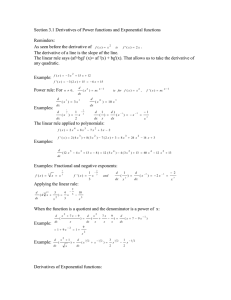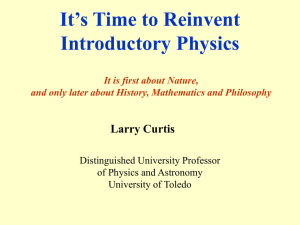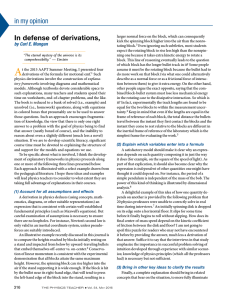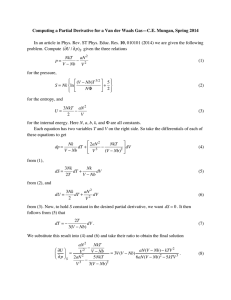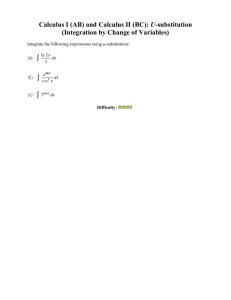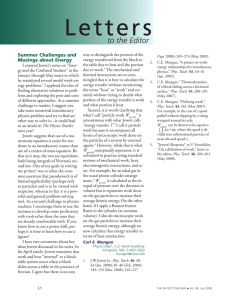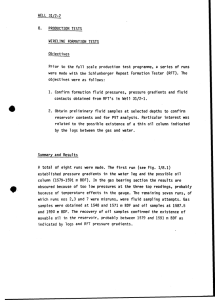LETTERS TO THE EDITOR
advertisement
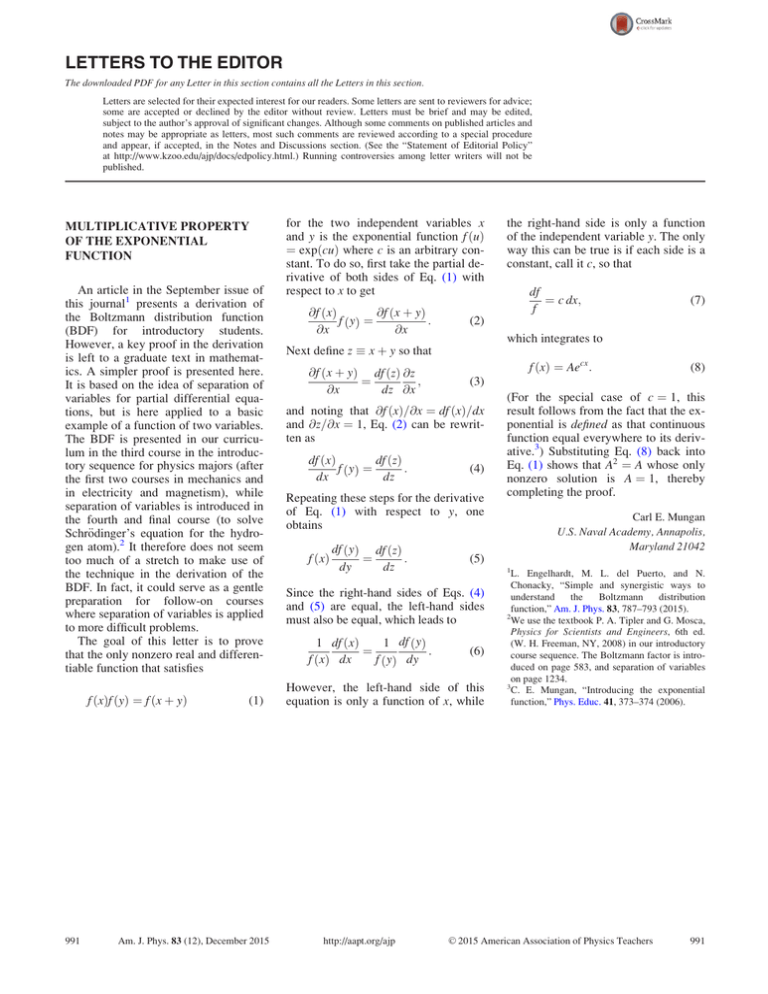
LETTERS TO THE EDITOR The downloaded PDF for any Letter in this section contains all the Letters in this section. Letters are selected for their expected interest for our readers. Some letters are sent to reviewers for advice; some are accepted or declined by the editor without review. Letters must be brief and may be edited, subject to the author’s approval of significant changes. Although some comments on published articles and notes may be appropriate as letters, most such comments are reviewed according to a special procedure and appear, if accepted, in the Notes and Discussions section. (See the “Statement of Editorial Policy” at http://www.kzoo.edu/ajp/docs/edpolicy.html.) Running controversies among letter writers will not be published. MULTIPLICATIVE PROPERTY OF THE EXPONENTIAL FUNCTION An article in the September issue of this journal1 presents a derivation of the Boltzmann distribution function (BDF) for introductory students. However, a key proof in the derivation is left to a graduate text in mathematics. A simpler proof is presented here. It is based on the idea of separation of variables for partial differential equations, but is here applied to a basic example of a function of two variables. The BDF is presented in our curriculum in the third course in the introductory sequence for physics majors (after the first two courses in mechanics and in electricity and magnetism), while separation of variables is introduced in the fourth and final course (to solve Schr€ odinger’s equation for the hydrogen atom).2 It therefore does not seem too much of a stretch to make use of the technique in the derivation of the BDF. In fact, it could serve as a gentle preparation for follow-on courses where separation of variables is applied to more difficult problems. The goal of this letter is to prove that the only nonzero real and differentiable function that satisfies f ðxÞf ðyÞ ¼ f ðx þ yÞ 991 (1) Am. J. Phys. 83 (12), December 2015 for the two independent variables x and y is the exponential function f ðuÞ ¼ expðcuÞ where c is an arbitrary constant. To do so, first take the partial derivative of both sides of Eq. (1) with respect to x to get @f ðx þ yÞ @f ð xÞ f ð yÞ ¼ : @x @x the right-hand side is only a function of the independent variable y. The only way this can be true is if each side is a constant, call it c, so that df ¼ c dx; f (7) (2) which integrates to Next define z x þ y so that @f ð x þ yÞ df ðzÞ @z ; ¼ dz @x @x f ðxÞ ¼ Aecx : and noting that @f ðxÞ=@x ¼ df ðxÞ=dx and @z=@x ¼ 1, Eq. (2) can be rewritten as df ðxÞ df ðzÞ f ð yÞ ¼ : dx dz (4) Repeating these steps for the derivative of Eq. (1) with respect to y, one obtains f ð xÞ df ð yÞ df ðzÞ ¼ : dy dz Carl E. Mungan U.S. Naval Academy, Annapolis, Maryland 21042 1 (6) However, the left-hand side of this equation is only a function of x, while http://aapt.org/ajp (For the special case of c ¼ 1, this result follows from the fact that the exponential is defined as that continuous function equal everywhere to its derivative.3) Substituting Eq. (8) back into Eq. (1) shows that A2 ¼ A whose only nonzero solution is A ¼ 1, thereby completing the proof. (5) Since the right-hand sides of Eqs. (4) and (5) are equal, the left-hand sides must also be equal, which leads to 1 df ð xÞ 1 df ðyÞ ¼ : f ð xÞ dx f ð yÞ dy (8) (3) L. Engelhardt, M. L. del Puerto, and N. Chonacky, “Simple and synergistic ways to understand the Boltzmann distribution function,” Am. J. Phys. 83, 787–793 (2015). 2 We use the textbook P. A. Tipler and G. Mosca, Physics for Scientists and Engineers, 6th ed. (W. H. Freeman, NY, 2008) in our introductory course sequence. The Boltzmann factor is introduced on page 583, and separation of variables on page 1234. 3 C. E. Mungan, “Introducing the exponential function,” Phys. Educ. 41, 373–374 (2006). C 2015 American Association of Physics Teachers V 991

